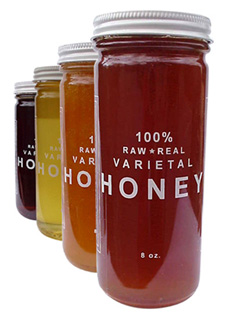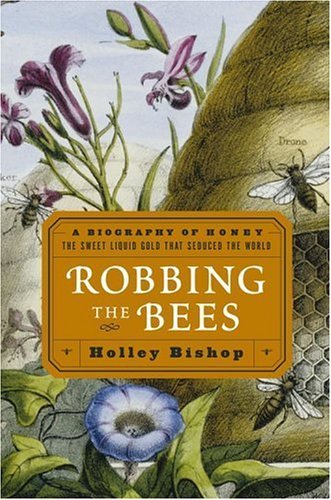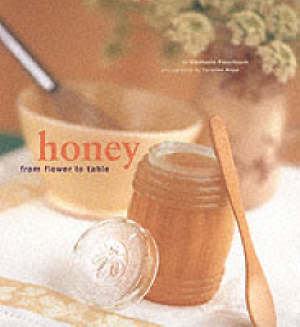Honey / Primary
Region |
About The Tree Or Shrub |
About The Honey |
Food/Beverage
Pairings |
Basswood Honey
Upstate New York
|
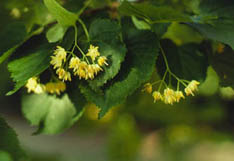
The blossoming basswood tree.
Clusters of cream-colored flowers are attached to a leafy bract and the nectar collects in the sepals. The honey is water-white with a good flavor. The basswood will usually grow quite well as an ornamental tree and is known for its shade and its nectar. |
Very light in color, basswood honey is delicate and crisp, with a bit of a bite, warm herbal notes and a distinctive, clean finish.
Basswood honey has a fresh taste often characterized as similar to green ripening fruit, both on the palate and in its lingering aftertaste.
|
Green apples |
| Fromage blanc |
| Vanilla ice cream |
| Beverage |
| Mint tea |
Blueberry Honey
Northeast |
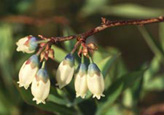
Photo courtesy of National Honey
Board.
Blueberries are prevalent in many areas of North America, primarily in the northern and eastern United States and Canada. Maine, Oregon, Michigan and New Jersey are some of the important blueberry-growing regions. Blueberries are self-sterile and must be cross-pollinated by bees. There are more than 20 species of low shrubs with bell-shaped white or pinkish flowers. All are much visited by bees. The honey is white with an excellent flavor.
|
Amber hued, blueberry honey is rich and dense and can have an aroma reminiscent of green leaves with a touch of lemon. It has a moderate fruity flavor with a delicate aftertaste. To best experience the taste, let the honey sit in your mouth for a short time. Many people can experience the actual taste of blueberries in the honey.
Blueberry honey also has a tendency to crystallize, although this has no impact on the flavor or quality. Crystals can be dissolved by putting the jar in warm water or for a few seconds in the microwave.
|
Hot cereal
|
Pancakes and waffles |
| On muffins and nut breads |
Beverage
|
| Cafe con leche |
Buckwheat Honey
Upstate New York |
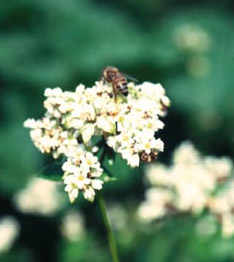
Photo courtesy of Diana Sammataro, Penn State University.
Buckwheat blooms quite early and the bees work it intensely in the mornings, becoming very cross in the afternoons when the nectar flow ceases. The honey is dark amber or purple, usually referred to as black. To many consumers the color resembles molasses —but the flavor is unforgettable.
|
Rich and dark brown in color, the strongly-flavored buckwheat honey is a favorite of many connoisseurs. It carries the distinct flavor of buckwheat: not a very sweet honey but one with a pungent, earthy and hay aroma, layers of malty and molasses flavors, and a long, pronounced finish.
|
With any strong cheese, especially blue cheeses |
| Paired with grapefruit is an excellent palate cleanser |
| Drizzled over spicy chili |
| Mixed with butter over cornbread, oatmeal, or anything that maple syrup would complement |
| When baking hearty breads or traditional honey cake |
| In barbecue sauce |
| Beverage |
| Hot milk or soy milk |
| Elderflower tea |
| Chicory coffee |
Cranberry Honey
Wisconsin
|
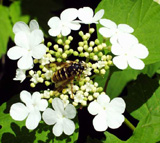
Photo courtesy of Blessed Bee Apiaries.
These low evergreen shrubs are an important cultivated crop in the Northeast. They also grow wild in some areas. Individual bogs do not bloom more than two weeks. Little or no honey is obtained when bees are placed for pollination, a requirement if cranberries are to be produced commercially.
|
Medium amber in color, cranberry honey truly reflects its floral source, with a delicate cranberry aroma. it is mildly tart yet smooth, with a pungent and lingering fruit finish. A favorite with chefs.
|
With dark chocolate in any form
|
| In cranberry sauce |
| In fruit preserves in place of sugar |
| Beverage |
| Cranberry and chamomile teas |
Desert Wildflower Honey
Arizona Desert
|
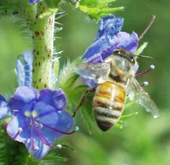
Photo courtesy of Blessed Bee Apiaries.
|
Light to medium amber in color, desert wildflower is a complex honey with lily notes and a sharp sweet finish. Sources for this honey include mesquite and cat’s claw.
|
Straight off the spoon
|
| In balsamic vinaigrette |
| On slices of crusty bread |
| Beverage |
| Herbal and green teas |
Orange Blossom Honey
Florida |
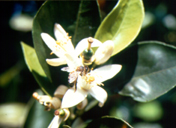
Photo courtesy of consult-iidc.com.
A leading honey plant in southern Florida, Texas, Arizona and California, Orange trees bloom in March and April and produce a white to extra-light amber honey with a distinctive flavor and the aroma of orange blossoms.
|
Orange blossom honey has a sweet and fruity taste, reminiscent of citrus blossoms.
Medium amber in color, orange blossom is a classic american honey. It is thick and full bodied with a strong floral aroma smooth citrus finish.
|
A versatile honey that can be used in a variety of culinary
applications:
• Great for baking
• Mix into salad dressings
• To glaze ham or brie
• Over ice cream, fruit salad, crumpets
|
| Beverage |
| English Breakfast, Assam or Ceylon teas |
| Chai |
| Lemonade (mix the lemon juice and honey together first, then add water) |
Raspberry Honey
Maine
|
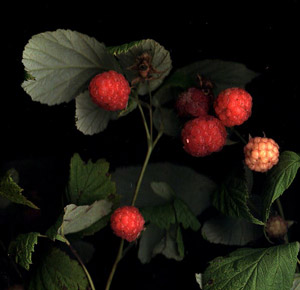
Photo courtesy of University of Wisconsin-Madison.
The raspberry plant is a thorny shrub that produces just one crop of fruit per year. Clusters of white, 5-petaled, rose-like flowers in spring give way to red raspberries which mature in summer.
|
Pale yellow in color, raspberry honey is light and floral with an aroma of cocoa butter and perfume. It is mellow and smooth on the palate. It is dessert honey.
|
Raspberry walnut vinaigrette |
| With pastry |
| Beverage |
| Raspberry and Earl Grey teas |
Sage Honey
California |

Sage honey comes from the sage bush of Western lore.
Shrubs 3 to 8 feet tall bearing two-lipped white flowers bloom from April to July along the coastal area of southern California from Santa Barbara to Mexico, in canyons and on mountain slopes to 2500 feet.
|
Translucent yellow in color, sage honey is mild with a slightly warm essence, a bit of pepper and a smooth clean finish. Sage honey is rich and light with a predominant sweet, clover-like flavor and an elegant floral aftertaste. Won't overpower other ingredients in recipes.
|
Chicken marinades and glazes
|
| Manchego cheese |
| Beverage |
Milder herbal teas, green tea
|
Saw Palmetto
Honey
Florida
|
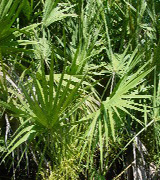
Photo courtesy of Fairchild Garden,
© C. Cairns.
Tall trees of up to 60 feet, palmetto tree trunks usually have persistent leaf bases and a single cluster of palmate leaves at the top. The whitish flowers occur in great compound clusters. Distributed from North Carolina south to Florida, palmetto is especially abundant along the coast and widely planted for ornamental reasons beyond its range.
|
Medium amber in color, saw palmetto honey is full-bodied, citrusy and herbal with woody overtones and a strong finish.
|
Baking
Ham and other meats
Hard Italian cheeses such as Asiago
|
| Beverage |
| Strong black tea |
Lemonade (mix lemon juice with honey first, then add water)
|
Sourwood Honey
North Carolina |
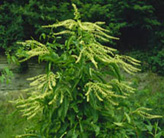
Photo courtesy of Virginia Tech
Department of Entomology.
In summer the sourwood
tree has long, drooping clusters of fragrant white flowers which resemble lily-of-the-valley. Sourwood tree leaves turn bright scarlet, orange or crimson in the fall, and are sour to the taste— but the blossom nectar yields a prized, spicy honey.
|
Sourwood honey has a sweet, spicy, anise aroma and flavor. It has a definite sour-tart quality, with hints of maple and a warm finish.
Medium amber in color, sourwood honey does not crystallize. It is a rare honey with a big local following, found only in the southern United States.
|
Asian foods
|
| Barbecue sauce |
| Beverage |
| Iced tea (add to tea before ice) |
| Try sparingly with stronger green teas |
| |
|
|
|




